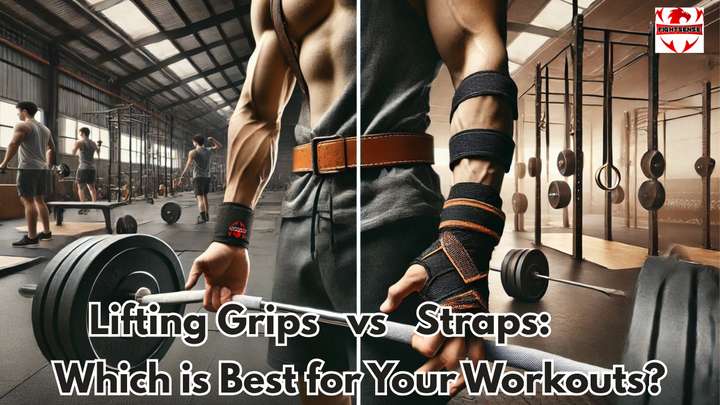Lifting Grips vs Straps: Which is Best for Your Workouts?
17th Apr 2025
Choosing the right gear can help you to maximize your gym performance. Many lifters have to decide critically between gymreapers weight lifting grips. Both are supposed to support your lifting program and improve your grip, even if they have different applications and strengths.
In this article, we will discuss the lifting grips vs straps against straps debate, considering its primary differences and directing you towards the one best fit for your training needs.
Keynotes:
- Grips provide flexibility and comfort while straps maximize grip strength for large lifts.
- Best for dynamic lifts; gymreapers weight lifting grips increase wrist mobility.
- Lifting straps are required for optimum deadlifts even if they restrict wrist movement.
- Including functional training and Olympic lifts, lifting grips are versatile and can be used for a large range of exercises.
- Wrist wraps can be combined with lifting grips for additional wrist support during large lifts.
What Are Lifting Grips?
Without compromising wrist flexibility, lifting grips helps you to increase grip strength. These accessories wrap over your hands to provide more traction and comfort when lifting. Made of strong materials like rubber, synthetic fabrics, or leather, lifting grips help prevent slippage and improve your grip on many gym equipment.
Its flexible form allows one to fit firmly while maintaining natural wrist movement for workouts calling both grip strength and wrist mobility.
What Are Lifting Straps?
On big lifts, however, lifting straps are supposed to give your wrists and hands best support. By surrounding the barbell and your wrists, these long straps give a constant grasp even when your hands start to weaken.
Among the exercises where lifting straps are typically used are deadlifts, shrugs, and rows since grip weariness can make hanging on the bar challenging. While lifting straps help to increase grip strength during maximum lifts, they restrict wrist movement and so are less flexible for activities requiring flexibility.
Gymreapers Weight Lifting Grips: The Ultimate Choice for Strength Training
When it comes to maximizing your performance in the gym, choosing the right equipment is crucial. Gymreapers weight lifting grips have become a popular choice for those serious about lifting.
These grips offer superior comfort and durability, allowing you to lift heavier and with more control. Compared to traditional lifting straps, weight lifting grips provide a better grip while reducing strain on your hands and wrists.
Lifting Grips vs Straps: Key Differences You Should Know
1. Comfort and Flexibility with Lifting Grips vs Straps
Two main differences between lifting grips and straps are comfort and adjustability. Made to tightly ring your hands without restricting wrist movement, lifting grips are pleasant and light weight to wear.
For dynamic, fast-paced exercises, whether your Olympic lifts are snatches, cleans, another lift, lifting grips are perfect since they allow your wrists to move freely. Conversely, rising straps could seem to be more constructive and heavier.
2. Grip Strength: Lifting Grips and Straps Performance
Lifting straps provide excellent hold for large lifts regarding grip strength. Deadlifts and other exercises where you have to keep lifting even when your grip strength starts to drop depend on lifting straps.
For activities like Olympic lifts, which need accuracy, they provide a strong grip on the bar while yet allowing you to feel the weight. If you respect control and technique, FightSense lifting grips provide the support you need without compromising your form.
3. Versatility: Which One Offers More Flexibility—Lifting Grips vs Straps?
Lifting grips vs Straps both support your wrists and hands even if they offer distinct types of protection. Lifting grips aid your hands thus minimize blisters and calluses even if they lack considerable wrist support. For athletes who wish to protect their wrists from strain during rigorous activities, using wrist wraps could be a better option.
Still, when employing lifting grips, your wrists stay completely in range of motion. If wrist health is a concern, wrist wraps worn with lifting grips provide more stability. Wearing wrist lifting straps will help anyone lifting very heavy weights or suffering wrist problems prevent extra damage.
4. Protecting Your Wrists: Lifting Grips vs Straps for Injury Prevention
While they offer various types of protection, lifting grips vs straps both help defend your wrists and hands during lifting. Lifting grips help your hands so less blisters and calluses are likely even though they lack considerable wrist support. Sportsmen who want to protect their wrists from strain during strenuous lifts might find wrist wraps to be a better option.
Still, when using lifting grips, your wrists still have full range of motion. Should wrist health be a concern, wrist wraps add more stability when used with lifting grips. Wearing wrist wraps will provide further help to prevent harm for people lifting particularly heavy weights or suffering wrist pain.
Why Choose Lifting Grips?
Your specific lifting straps and grips requirements will guide you in choosing them. Lifting grips are a better choice if you value wrist flexibility and adaptation. Perfect for a range of exercises, they increase your grip strength without compromising wrist flexibility.
FightSense lifting grips vs Straps provide the comfort and support needed to perform excellently in your workouts, regardless of your training—strength, endurance, or technique.
Shop Now!
Conclusion:
Your individual goals and the kind of exercises you do will finally decide whether or not you utilize lifting grips vs straps. If your focus is on maximum strength during large lifts, lifting straps might provide the extra grip support you need to push past your restrictions.
The best option is lifting grips, although if you like a more cozy and flexible alternative that also promotes wrist flexibility as well as grip.
Disclaimer:
Always contact a fitness trainer or healthcare professional before including new lifting equipment into your program—especially if you have wrist injuries or other medical problems.

